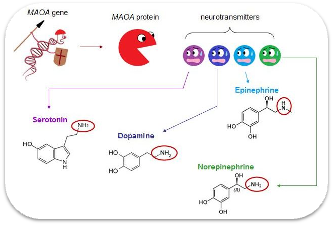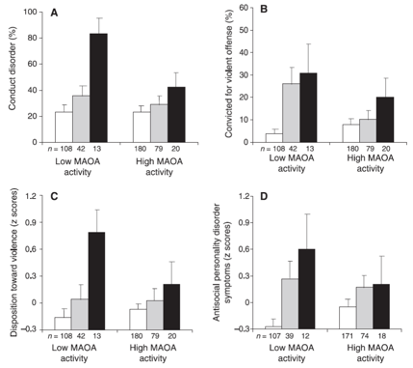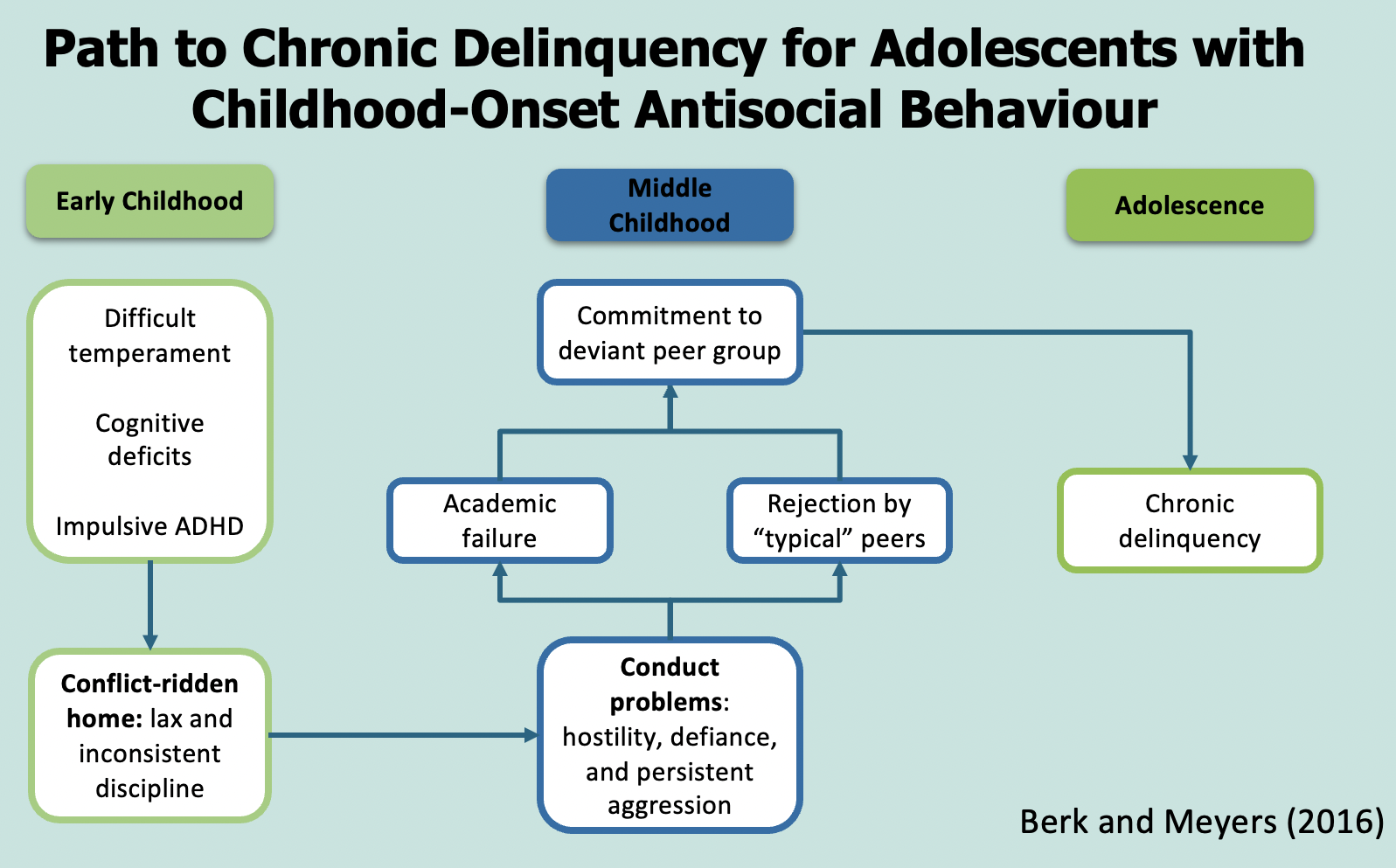Lecture 8: Adolescent Social Development II
1/49
Earn XP
Description and Tags
1. moral development ; 2. antisocial behaviour ; 3. adolescent delinquency
Name | Mastery | Learn | Test | Matching | Spaced |
|---|
No study sessions yet.
50 Terms
‘introduction’ to morality
morality as inherently social (guided by societal norms and structures) and as functional (for the purpose of social cohesion)
many models of morality within and outside of psych
cld argue purpose of morality is to elicit ‘moral behaviour’; consequentialism vs deontology
moral values and behaviours value across time and cultures
moral reasoning vs moral behaviour (Jones, 1991)
identify moral problem → moral reasoning (cognition) → moral intent (plan for behaviour) → moral behaviour
between moral intent and moral behaviour is intention-behaviour gap
feeding into moral reasoning and moral intent are social factors
there is also moral intensity
moral intensity
magnitude of consequences
social consensus
probability of effect
temporal immediacy
proximity
concentration of effect
social factors feeding into moral reasoning and moral intent
group dynamics
authority figures
socialisation processes
moral development
involves change of thoughts, feelings, intentions, and behaviours in response to standards of ‘right and wrong’
Kohlberg’s Stages of Moral Development
Preconventional Level
Stage 1: Punishment and obedience
Stage 2: Instrumental purpose
Conventional Level
Stage 3: “good boy/girl”
Stage 4: social order maintenance
Postconventional Level
Stage 5: Social contract
Stage 6: Useful ethical principles
Preconventional Level
early to late childhood
individual has no moral value
worry about avoiding punishment by adults/more powerful people
motivated by self interest
Stage 1: Punishment and obedience
Stage 2: Instrumental purpose
Stage 1 (Kohlberg)
at the preconventional level
punishment and obedience / obedience and punishment orientation
behaviour driven by avoiding punishment and obeying authority without question
Stage 2 (Kohlberg)
at the preconventional level
instrumental purpose/ individualism and exchange
right behaviour = acting in own best interests and recognising others also have their interests
Conventional Level
adolescence
individuals abide by certain standards, but they are standards of others
concerned with meeting external social expectations
Stage 3: Good interpersonal relationships/ “Good boy/girl”
Stage 4: Social order maintenance
Stage 3 (Kohlberg)
at the conventional level
“Good boy/girl” / Good Interpersonal Relationships
good behaviour is about living up to social expectations and rules, and emphasising trust, caring, and loyalty to others
Stage 4 (Kohlberg)
at the conventional level
Social order maintenance / Maintaining social order
right behaviour involves fulfilling one’s duties, respecting authority, and maintaining social order
Postconventional Level
late adolescence and onward, not reached by everyone
morality is completely internalised
concern for fidelity to self-chosen moral principles
universal ethical principles
Stage 5: Social contract / Social contract and individual rights
Stage 6: Universal ethical principles / Universal principles
Stage 5 (Kohlberg)
at the postconventional level
Social contract/ Social contract and individual rights
moral behaviour understood in terms of individual rights and standards that have been agreed upon by the whole society
Stage 6 (Kohlberg)
at the postconventional level
Universal ethical principles/ universal principles
morality is based on abstract reasoning using universal ethical principles
laws valid only insofar they are grounded in justice
describe Kohlberg’s Stages of Moral Development in terms of changeability, individuals, etc
stages not fixed
can vary significantly depending on individual experiences, education, culture
not all individuals will reach postconventional level as it requires advanced cog dev and specific opportunities to engage in deeper moral reasoning
what does it require to reach the postconventional level?
advanced cognitive development
specific opportunities to engage in deeper moral reasoning
describe morality during adolescence
conventional level
moral values + standards are internalised (become part of one’s identity)
moral reasoning develops during adolescence as social experiences, autonomy, and cognitive functions increase (Malti & Latzko, 2010)
moral ____a____ develops during adolescence as __b__ ____b___, ____c_____, and ___d____ ___d____ increase. (Malti & Latzko, 2010)
a) reasoning
b) social experiences
c) autonomy
d) cognitive functions
explain morality during adolescence
development of social cognition and executive functioning as a result of frontal brain development during adolescence → often linked to increased proficiency in moral reasoning (Vera-Estay et al., 2015)
criticisms of Kohlberg’s theory
moral reasoning may NOT lead to moral behaviour → internal validity
early research only w male Ps who were white and relatively privileged → unrepresentative sample → lack generalisability; WEIRD; bias; beta bias
emphasises justice over other moral values (e.g. compassion, caring) → subjective; may overlook
culturally biased: evidence suggests diff cultures move thru stages at diff rates + may focus on diff moral values → ethnocentrism; imposed etic; culture bound
factors influencing moral development
education
social media
cultural norms
peers & family
identity development
neural & cognitive development
are we born with brains hardwired for morality? idea of ‘the moral brain’
no single neural network or structure can account for all aspects of moral reasoning and behaviour
different aspcts of morality governed by different cortical and subcortical neural circuits and interact w life experiences
(Pascual et al., 2013)
neural correlates of moral decision-making
activation in left middle temporal, cingulate, and medial frontal gyrus; left/right dg temporal gyrus; right precuneus → associated w/ moral decision making (Garrigan et al., 2016)
regions are involved in self-referential processing, attention, WM, emotional recognition, empathetic arousal
→ suggests no single region responsible
antisocial behaviour: broad legal definition
behaviour which causes/is likely to cause harassment, alarm, or distress to non-same-household people
(Antisocial Behaviour Act, 2003; Police Reform and Social Responsibility Act, 2011).
antisocial behaviour: specific behaviours definition
in children/adolescence, can be characterised by:
verbally and physically harmful to other people
violating social expectations
delinquency, vandalism, theft, truancy
disturbed interpersonal behaviour
very heterogenous amongst young people
(Otto et al., 2021)
influential factors in adolescent antisocial behaviour
moral identity
self-regulation
moral disengagement
(Hardy et al., 2015)
explanation for high prevalence of antisocial behaviour during adolescence: morality + antisocial behaviour
moral development coincides w sensitive period of cognitive and neural development
+ increased propensity to take risks, sensitivity to pos/neg stimuli, sensitivity to influence of peers
children who experience abuse and maltreatment are at risk of…
becoming violent offenders, developing conduct disorder, having antisocial personality
development of antisocial behaviour: NURTURE
risk:
childhood maltreatment/abuse
protective:
religiosity
peers
development of antisocial behaviour: NATURE
risk:
MAOA-l
MAOA gene
low activity variant associated w/ increased aggression, some link to psychopathy
linked to X chromosome
produces protein MAOA which breaks down excess neurotransmitters including dopamine and serotonin
excess neurotransmitters → increased propensity for aggression
MAOA-l → reduced activity of MAOA enzyme/protein → higher levels of dopamine, serotonin, noradrenaline → higher aggression

interaction → antisocial
interactions between MAOA and childhood maltreatment predict later antisocial behaviour
only when genetic predisposition is combined with childhood maltreatment does it result in adult antisocial behaviour
→ environment protective

label the shades: white, grey, black
white- no maltreatment
grey- probable maltreatment
black- severe maltreatment
Prof. James Fallon: neuroscientist who discovered he was a ‘psychopath’
possesses all characteristics of ‘psychopath’
MAOA-l
professor… not killer
concluded success partly due to psychopathic tendencies: manipulation, risk taking, etc
but, grew up in loving family → believes protected him from genetic predispositions
→ nature + nurture
protective factors against antisocial behaviour
religiosity
peers
religiosity as a protective factor against antisocial behaviour
adolescents who remain part of a religious community:
less likely antisocial behaviour
more involved w community service
less misconduct
lower rates drug and alc abuse
less likely early sexual activity
peers as a protective factor against antisocial behaviour
can act as models for prosocial (or antisocial) behaviour
can provide support in presence of unsupportive or confrontational familial relationships
delinquency
according to acts prohibited by criminal law, such as theft, burglary, robbery, violence, vandalism, and drug use
(Murray, 2010)
→ NOT same as antisocial behaviour
what is linked to conduct disorder?
adolescent/ juvenile delinquency
conduct disorder
repetitive and persistent pattern of behaviour where the basic rights of others or major age-appropriate societal norms or rules are violated, as shown by at least 3/15 criteria in past 12 months
→ persistent delinquency
increasing and chronic trajectories of delinquent behaviour in childhood predicts outcomes for…
partner violence, risky sexual behaviour, and depression at age 19 for m and f (Miller et al., 2013)
adolescent delinquency stats
15,800 between 10-17 cautioned or sentenced in 2021, UK
decreasing last decade UK
rises over early and mid, declines

Murray and Farrington (2010: Risk of Delinquency and Conduct Disorder
Risk:
Social factors
SES
school area
community area
peer influences
Individual factors
impulsiveness
low IQ
low educational achievement
Family factors
parenting
child abuse
parental conflict and disrupted families
routes to adolescent delinquency
early onset
behaviour begins in childhood
biological risk factors and child rearing practice are combined risk factors
late onset
behaviour begins around puberty
conduct problems arise from peer context of early adolescence
path to chronic delinquency for adolescents with childhood onset antisocial behaviour
Early Childhood:
difficult temperament; cognitive deficits; ADHD-I
→
conflict-ridden home: lax and inconsistent discipline
→
Middle Childhood:
conduct problems: hostility, defiance, persistent aggression
→
academic failure and/or rejection by ‘typical’ peers
→
commitment to deviant peer group
→
Adolescence:
chronic delinquency

prevention and intervention of adolescent delinquency: Averdijk et al., (2016): study
cluster randomised control trial
1675 children
Switzerland
one or two psychosocial interventions at 7 and 8 y/o:
Promoting Alternative Thinking Strategies (PATHS; socioemotional skills)
Triple P (cog-beh parenting program)
outcomes measured at 13 and 15
13 outcomes related to delinquency, substance use, and antisocial behaviour
prevention and intervention of adolescent delinquency: Averdijk et al., (2016): findings
PATHS intervention only → significantly less police contact
PATHS + Triple P → worse conflict resolution competence
all other effects either non-sig or negligible size
factors that foster resilience in adolescence: Arthur et al., (2002)
belief in moral system and religiosity
high social skills
rewards and opportunities for prosocial family interactions (like the ones afforded by authoritative parents)
rewards and opportunities for involvement in the school and community
factors that foster resilience in adolescence: Farrington et al., (2016)
low neuroticism and few friends are promotive factors → predict low probability of delinquency
high intelligence and educational attainment → protect against risk factor of poor child rearing
high family income → protects against risk factor of convincted parent